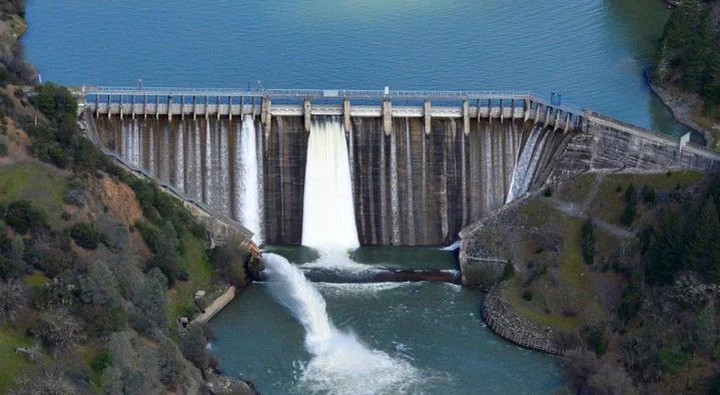Scott Dam, with Lake Pillsbury behind it. Photo: PG&E.
PREVIOUSLY:
###
About a month ago, the Lake County Board of Supervisors begged President Donald Trump to put a halt to the deal to remove the two antiquated hydropower dams way up near the headwaters of the Middle Fork main stem of the Eel. That deal was reached in mid-February, after years of negotiations.
PG&E doesn’t want the dams anymore. It plans to petition the Federal Energy Regulatory Commission to allow them to be removed, in a process that would mirror the historic undamming of the Klamath.
But Lake County wanted to throw some sand in the gears, and now that body is joined by the local chapters of the Farm Bureau in Lake, Mendocino, Sonoma and Marin counties. Last week, they sent a letter to President Trump, who has made speeches about the folly of allowing the water in California rivers to return to the sea, and in that letter they petition the president to order FERC to keep the dams in place.
Here’s the letter from those Farm Bureaux.
Here’s a press release from Friends of the Eel:
Turning a blind eye to serious safety and reliability concerns, as well as questioning a private company’s business decision, the Farm Bureaus of Marin, Sonoma, Lake, and Mendocino Counties have asked the Trump administration to halt or delay the removal of Scott and Cape Horn Dams.
The dams comprise the Potter Valley Project on the upper Eel River. Dam owner Pacific Gas and Electric (PG&E) must surrender its current federal license to operate the dams, and intends to remove them starting in 2028. A separate agreement announced this February by Eel and Russian River interests proposes construction of a new, low-impact facility to maintain a reliable water supply to the Russian River through wet-season diversions from the Eel.
In an April 5 letter, the agriculture organizations argue that, instead, the federal Bureau of Reclamation should acquire the dams from PG&E and continue to operate them for the benefit of Russian River water users. Alternatively, they propose Eel River dam removal be delayed until Coyote Dam, on the upper Russian River east of Ukiah, is raised to provide additional storage in the Lake Mendocino reservoir.
PG&E has been clear that it does not make economic sense to operate the Potter Valley Project. In 2021 when the project’s transformer failed, PG&E ultimately decided not to replace it. At the time, the company projected it would take 18-24 months, at a cost of $5-10 million. Without a transformer, the project produces no electricity. But with renewables surging, especially cheap solar and batteries, PG&E doesn’t need the expensive electricity the Eel River dams used to make. Even when the project was producing power, PG&E estimated that operating the project cost more than 20 times its revenue.
Simply put, Scott and Cape Horn dams have come to the end of their useful life. Scott Dam, built in 1922, has accumulated so much sediment that its operations are restricted and dam failure is an ever-increasing threat. If the water level in the Lake Pillsbury reservoir falls too low or too quickly, PG&E engineers warn, the accumulated sediments near the base of the dam will fall down and clog the only low-level water outlet on Scott Dam. That would end diversions entirely.
However, it is Scott Dam’s vulnerability to seismic damage that is the real headline. Over the last 20 years, the US Geological Survey has mapped the Bartlett Springs Fault. We now know what Scott Dam’s builders did not: that the dam sits nearly atop the fault, near the middle of its more than hundred-mile length. We know that the fault can create earthquakes of magnitude 7 and greater.
And we know that in 2023, within a week of PG&E receiving an assessment of Scott Dam’s seismic vulnerability, the utility lowered the radial gates atop the dam. We also know that the California Division of Safety of Dams told PG&E they can’t raise those gates again without permission. These gates were built to compensate for volume lost to sedimentation; lowering them reduces reservoir capacity by about 20,000 acre feet. Between seismic risks, sediment problems, and the need to avoid harming Eel River fisheries, diversions from the Project have become at best unreliable.
Not if, but when Scott Dam’s only low-level water outlet is clogged, or an earthquake topples the whole thing, the diversion to the Russian River will end. The best way for Russian River interests to secure a reliable diversion is not to fight Eel River dam removal, but to remove the antiquated dams now and build a modern, run-of-the-river diversion structure. Of course, they must also continue working toward self-sufficiency within their own watershed.
The critically imperiled salmon and especially steelhead of the Upper Eel River need dam removal as soon as possible. And the commercial fishing industry desperately needs relief as they look toward a potential third disastrous year of fishery closure. Against piles of evidence and analysis, the farm bureaus claim instead there’s some magically cheap and effective way to provide fish passage over Scott Dam. There is not.
The farm bureau proposal appears to align with the federal administration’s ambitions of rolling regulations back to the 1950s. Back then PG&E and the Russian River took as much of the Eel’s flows as they wanted whenever they wanted, driving Eel River salmon and steelhead toward extinction. It would also be deeply unfair to expect PG&E’s already-burdened ratepayers to carry the costs of keeping the Eel River dams operating for the benefit of wealthy landowners and perpetuating the injustice to farmers, towns, fishermen, and Tribes in the Eel River. That is the essence of this predatory proposal: powerful entities resisting change to unsustainable systems because they benefit from the status quo.

CLICK TO MANAGE